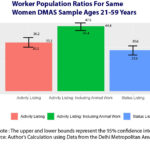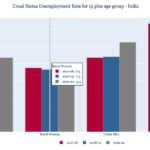Illusory or real? Unpacking the recent increase in women’s labour force participation in India
From recording a substantial decline in the first two decades of the millennium, India’s female labour force participation is finally showing some improvement. What’s driving this shift?
Key Highlights
- India’s labour force participation rate (for those aged 15-59) has seen a growth from 51.5 percent to 58.3 percent between 2017-18 and 2022-23
- This growth has been on account of improvement in women’s labour force participation rates, particularly in rural areas
- The improvement in the initial years can be partially explained by a change in measurement
- The sustained increase reflects an increase in women in self-employment, which is a combination of paid work and disguised unemployment. There is, however, no increase in job availability in rural areas
When the World Economic Forum released the Global Gender Gap Report for 2022 caused jaws to drop and eyes to pop out as it put Saudi Arabia, where gender gaps are mandated by law, ahead of India in terms of their respective rankings on the gender gap index. In the following year, while India did manage to outrank its West Asian counterpart marginally, it continues to rank fairly low – 127 among 146 countries. The index measures gaps on four broad parameters (also called sub-indices) — economic participation and opportunities, educational attainment, health and survival, and political empowerment. India’s poor scoring on “economic participation and opportunities” for women contributed substantially to India’s persistently low rank in the global list.
A large part of “economic participation and opportunities” relates to women’s participation in the labour force. The issue of low and declining female labour force participation rate (FLFPR) in India has been extensively discussed both on CEDA pages (see examples here, here, here and here) as well as by CEDA researchers who have analysed some key causes, patterns showing that women work when work is available and suggested remedies based on rigorous empirical research.
In this context, data from the Periodic Labour Force Surveys (PLFS) since 2017-18 provides more than a glimmer of hope as it reveals a rise in the overall labour force participation rate (LFPR) by the current weekly status (or CWS, where the reference period is one week) of those aged 15-59 from 51.5 percent to 58.3 percent between 2017-18 and 2022-23 (Figure 1).
This increase is driven by an increase in FLFPRs from 22.9 to 34.1 percent over the period. If this is indeed the beginning of a new trend, it is undoubtedly heartening and very welcome. PLFS also provide data for participation rates by usual status (principal and subsidiary status) with a reference period of one year. Here we report figures from CWS, but the usual status trends are similar.
True to historical pattern, the urban FLFPR continues to be lower than rural, but both show an increase: 5 percentage points for urban and 14 percentage points for rural women. The pattern of increase in rural women’s LFPRs shows two big spikes of roughly 6 percentage points each: one between 2018-19 and 2019-20 and the second between 2021-22 and 2022-23. The corresponding urban increase was around 2 percentage points in both instances.
It would be useful to remind ourselves of the trends in LFPRs prior to 2017-18.
India’s FLFPR declined from 39.7 percent in 2004-05 to 28.9 percent in 2011-12, to a further 22.9 percent in 2017-18 (Figure 2). The Indian government started using the PLFS only in 2017-18. Prior to that, the quinquennial Employment-Unemployment Surveys (EUS) were used to measure the employment situation in the country. The EUS was conducted by the National Sample Survey (NSS) under the Ministry of Statistics and Programme Implementation (MoSPI), the same ministry that now conducts PLFS.
The recent increase in FLFPRs is being driven by the increase in rural women’s increased participation, just as the decline was due to a drop in rural FLFPR. Let us try to understand the increase using the same set of arguments that have so far been deployed to analyse the decline.
Is this a norms story?
Both the historically low level as well as the decline in female LFPRs have been widely attributed to conservative social norms, both by academics as well as by multilateral organizations. The crux of this argument is that women are not allowed by their families and by the local community to participate in paid work, a norm that women themselves largely internalize. If this argument is true, the latest increase in India’s FLFPR is a puzzle. Did norms governing Indian women (assuming incorrectly in the first place that there is a common set of norms applicable across castes and communities) suddenly and inexplicably loosen over the last six years, in two bouts? That seems highly unlikely. There is no complementary evidence from any other source that hints at this possibility.
Is this a measurement story?
We might wonder about the accuracy of the recent data, and indeed there is much to say about measurement of women’s work. Does the recent increase reflect a changed way of measuring women’s work? When the EUS was replaced by the annual PLFS, there were some changes made to the sampling design and interview schedules. Readers interested in the full set of changes can refer to this document.
As we know, labour force participation rates measure both participation in economic work as well as availability for economic work. International standards count economic work as employment for pay or profit; by this standard, an unpaid helper would not be counted as being in the labour force. However, in developing countries like India, there is a large number of workers, especially women, who are involved in economic work, i.e., in the production of goods and services that get counted in GDP but are not paid for that work. Women in unpaid economic work tend to fall through the cracks of the statistical system and not get counted as workers.
While it is difficult to be absolutely sure from the outside, it is possible that among the new features of PLFS, two might have contributed to better measurement of women’s work: one, for each day of the reference week, PLFS collected hours worked in each economic activity. Second, for those who were available for additional economic work in the reference week, information on hours available for each day of the reference week was collected.
To the extent this is a measurement story, we could argue that the earlier low proportions reflected mismeasurement of women’s work and the recent increase reflects improved measurement. However, this would explain only the initial increase, i.e., the first couple of PLFS rounds. It cannot explain the steady increase over six years. It is difficult to imagine that each year is more accurate than the previous year. Instead, it suggests a genuine increase in women entering productive work. But is this coming from an increase in jobs for women?
Is this about more jobs in rural India?
This recent increase in FLFPR could not be due to a sudden increase in work availability in rural areas, as we do not observe any corresponding spikes in the labour force participation rates of rural men. As Figure 3 shows, that increase is driven by an increase in proportion of rural women under the broad category of “self-employed”, which has risen from 55.9 percent in 2017-18 to 70.1 percent in 2022-23.
What does self-employment encompass? In brief, it includes any activity where one is not working for an employer. It could include the largest entrepreneurs as well as a farmer, the neighbourhood cobbler or the vegetable seller on a cart. For those not in wage or casual work, participation in agriculture and allied activities counts as self-employment. The PLFS further categorizes those who are self-employed into three categories: “employer”, “own-account worker” and “unpaid helper”. Own-account workers are one-person enterprises and unpaid helpers typically are individuals working on family enterprises but not being paid for their labour.
In the first spike in FLFPR between 2018-19 and 2019-20, it was the proportion of unpaid helpers within self-employed that increased (from 33.1 to 38.4 percent), while the proportions of self-employed that were own-account workers declined from 22.9 percent to 20.9 percent. The proportion of rural women workers who worked as regular salaried workers also declined from 13.4 to 10.3 percent.
In the second spike more recently between 2021-22 and 2022-23, it was the proportion of women working as own-account workers that increased, whereas the proportion as unpaid workers remained stable at roughly 38 percent. Thus, the increase in female LFPRs is attributable to an increase in proportions of women working as own-account enterprises or as unpaid helpers.
Additionally, we see a decline in the share of rural women working as casual labour (from 31.3 percent to 19.6 percent) and no change in the proportion working in regular wage or salaried jobs (roughly 10 percent). If job availability in rural areas had increased, we would have seen an increase in both these proportions.
Normally a shift from casual labour to regular wage labour signals an improvement in work conditions. However, Indian data does not show this shift. It appears that a decline in the proportion of women as casual labour is being more than compensated by an increase in two subsections of the self-employed category: unpaid helper and own account worker.
Is this disguised unemployment?
Between 2017-18 and 2022-23, the share of men who were employed in the primary sector (agriculture, forestry and fishing) declined from 37 percent to 33.4 percent. However, for women, this share went up from 52.8 to 58.8 percent (Figure 4).
Most of the growth in the share of self-employed women, especially of those working as own-account workers has also been in this sector in this period. Figure 5 shows the change over time in proportion of men and women across broad sectors and by type of employment in rural and urban areas.
Focusing on rural women, there has been a steady increase in the proportion that are self-employment in agriculture from 63.7 percent in 2017-18 to 79.1 in 2022-23, an increase of roughly 15 percentage points. There has also been an increase in the proportion of self-employed rural women in manufacturing and services, though quantum of increase is smaller: 10 percentage points for manufacturing, from 71.7 to 81.8 percent, and six percentage points for services from 23.1 to 29.1 percent (even as the share of women working in manufacturing has only increased marginally while those working in services has seen a small decline). Thus, self-employment among rural women has occurred across sectors.
may not add upto 100 percent. Source: Periodic Labour Force Survey (Various rounds)
The increase in self-employment in agriculture for rural women is mirrored in the steady decline in the proportion working as casual labour in agriculture, with virtually no change in the proportion of women in regular salaried jobs.
Had the decline in casual labour been reflected in an increase in regular salaried jobs, it would have indicated an improvement in job quality. However, that is not the case. The increase in self-employment in agriculture could reflect disguised unemployment or underemployment, which refers to a situation where too many workers are doing too few jobs. This essentially means that women are engaged in agriculture but not to their full productive capacity. This is reflected in the pattern of earnings over time.
Are self-employed women earning more?
Figure 6 shows gross earnings in constant prices from self-employment separately for four quarters for the six years, separately for rural and urban areas for male and female workers.
We see that the real gross earnings of rural self-employed women have declined over the six years for each quarter. For the April-June quarter, the ratio of their 2022-23 earnings relative to 2017-18 is almost unchanged at 99.8. For all other quarters, we see a clear decline. The ratio is 93 percent (January-March); 91 percent for July-September and 89 percent for October-December. Thus, while PLFS is doing a better job of counting economic participation of women, it also reveals clear gaps in earnings of the self-employed, the category of women that is driving the increase in LFPR measurement.
What about salaried work?
While the proportion of women in regular salaried work has not increased, we should note that daily wages for rural women have increased in real terms (Figure 7), as indeed they have for urban women.
This increase has been accompanied by some improvement in working conditions. There has been a decline in the proportion of female workers with no job contract: from 57.8 to 50.2 percent in rural areas and from 71.72 to 55.61 percent in urban areas between 2017-18 and 2022-23. A similar improvement is also recorded for rural and urban men.
However, the proportion of women in regular salaried work with no social security benefits has increased from 54.9 to 58 percent in rural and from 49.8 to 51.1 percent in urban areas. Among men, this share increased from 51.6 percent in 2017-18 to 59.3 percent in 2022-23 in rural areas, while in urban areas it increased marginally from 46.5 percent to 47 percent in the same period.
On balance, women in salaried work have seen some improvements. However, the problem is that the proportion of women in salaried work is barely 20 percent of the 34 percent women who are in the labour force.
What lessons does this hold for policy?
There is an urgent need to increase women’s participation in regular salaried paid work with job contracts and social security benefits. This would be the most important step, albeit not the only one, towards women’s economic empowerment. To achieve this, rural non-farm paid employment opportunities would need to be expanded. Additionally, barriers such as the lack of decent, fast and safe transportation or childcare facilities would need to be alleviated so that women are able to access work within commuting distance.
As job availability and the demand for female labour improves, women will gradually start to enter paid work, as they have done in every society in the world. This will finally start to shift the needle on the norm that prevents women from accessing paid work: that women are predominantly responsible for all household chores (cooking, gathering fuel, cleaning, washing dishes, laundry, house maintenance, childcare, elderly care etc.). History tells us that norms are sticky. To accelerate the change, public messaging from the highest quarters should strongly advocate the message of gender equality within the household.
If you wish to republish this article or use an extract or chart, please read CEDA’s republishing guidelines.







